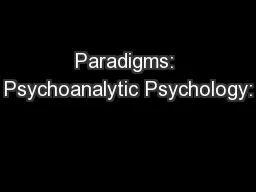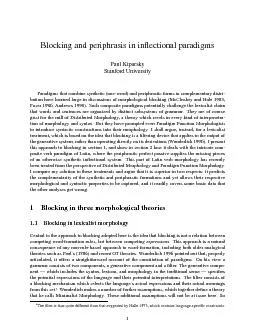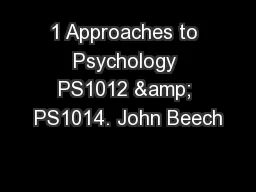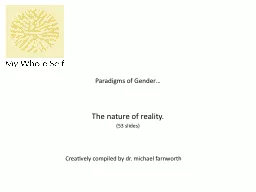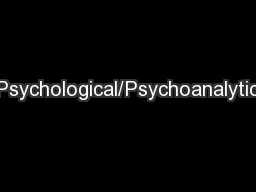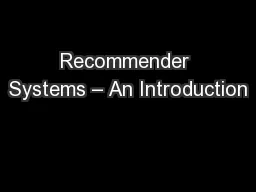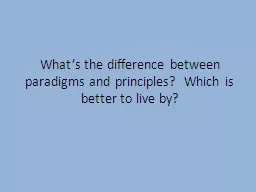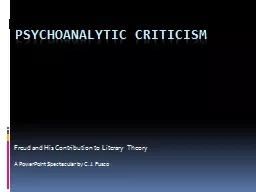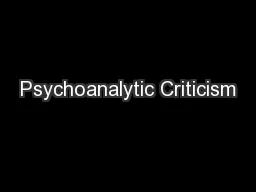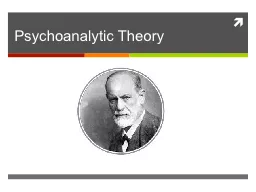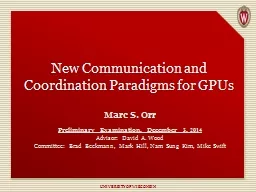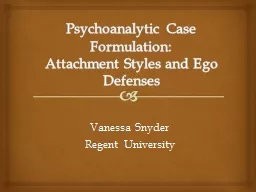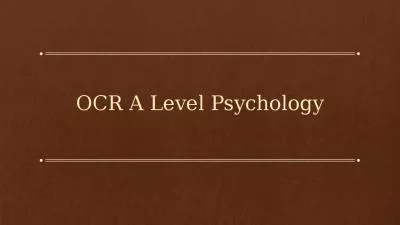PPT-Paradigms: Psychoanalytic Psychology:
Author : ellena-manuel | Published Date : 2017-08-26
Not Dead Yet Paradigms 1 Viewpoints Models Perspectives Approaches Paradigms 2 Same behaviour can be viewed in different ways by different paradigms Determine the
Presentation Embed Code
Download Presentation
Download Presentation The PPT/PDF document "Paradigms: Psychoanalytic Psychology:" is the property of its rightful owner. Permission is granted to download and print the materials on this website for personal, non-commercial use only, and to display it on your personal computer provided you do not modify the materials and that you retain all copyright notices contained in the materials. By downloading content from our website, you accept the terms of this agreement.
Paradigms: Psychoanalytic Psychology:: Transcript
Not Dead Yet Paradigms 1 Viewpoints Models Perspectives Approaches Paradigms 2 Same behaviour can be viewed in different ways by different paradigms Determine the causes treatments what should be studied. Whist eery eo rt is made to ensure accuracy there may be phonetic or other errors depending on ineitabe a riations in recording 0uaity Pease do contact us to point out any errors 1hich 1e 1i endeaour to co rrect To reproduce any part o this transcri paradigms Paul Kiparsky Stanford University Paradigms that combine (one-word) and forms bution have large discussions of (McCloskey and Poser Andrews 1990). Such paradigms lexicalist words sentences o The Cognitive Approach to Psychology. 2. Cognitive Approach. Two sections:. Paradigms of the cognitive approach.. The historical development of the cognitive approach.. 3. What is Cognitive Psychology? . The nature of reality. .. (. 53 . slides). . Creatively . compiled by. dr. . michael. . farnworth. Adam Smith: . The Power of the Mind. , page 19. “. The paradigm is a shared set of . Criticism. What is Psychoanalytic Criticism?. critics begin with a full psychological theory of how and why people behave as they do, a theory that has been developed by a . psychologist /. psychiatrist. Dietmar. . Jannach. , Markus . Zanker. , Alexander . Felfernig. , Gerhard Friedrich. Cambridge University Press. Which digital camera should I buy. ?. What is the best holiday for me and. my family. PARADIGM. The way you see something,. your point of view,. frame of reference,. or belief.. Why are paradigms harmful to us?. Sometimes our paradigms are way off the mark and we end up creating limitations for . Freud and His Contribution to Literary Theory. A PowerPoint Spectacular by C.J. Fusco. Sigmund Freud. Sigismund . Schlomo. . Freud. (1856-1939), . was an Austrian neurologist usually credited with creating psychoanalytic theory and, by extension, psychiatric therapy. . Literary Criticism and Theory. Psychoanalytic Criticism. A Bunch of Psycho-babble?. Uses some of the techniques of psychoanalysis to interpret literature. A part of everyday life. Internet and television has fueled our “knowledge” about psychoanalysis—no matter how simplistic. . Shantenu Jha represented by . Geoffrey Fox. gcf@indiana.edu. . . http://www.infomall.org. . http://www.futuregrid.org. . . http://salsahpc.indiana.edu/. . Director, Digital Science Center, Pervasive Technology Institute. Definition. Psychoanalytic criticism applies the psychological principle and theory of how and why people behave to literature to interpret and evaluate it.. Focus. Tenet/ Main Points. Key Concepts. Most of the individual’s mental processes are unconscious. Highly-parallel Accelerators. Marc . S. Orr. PhD Defense, . December . 5. , . 2016. Advisor: David A. Wood. Committee. : Brad Beckmann, Mark Hill, Nam . Sung Kim,. Karu. . Sankaralingam. , and Mike Swift. Attachment Styles and Ego Defenses. Vanessa Snyder. Regent University. Dr. Nancy McWilliams:. Professor at Rutgers University. Author:. Psychoanalytic Diagnosis . Psychoanalytic Case Formulation. Psychoanalytic Psychotherapy: A Practitioner’s Guide. The study of people – how they act, react, and interact. Explores areas such as learning, memory, development of children, sport, social behaviour, cognitive processes and human development.. A science. Psychological studies involve the use of...
Download Document
Here is the link to download the presentation.
"Paradigms: Psychoanalytic Psychology:"The content belongs to its owner. You may download and print it for personal use, without modification, and keep all copyright notices. By downloading, you agree to these terms.
Related Documents

